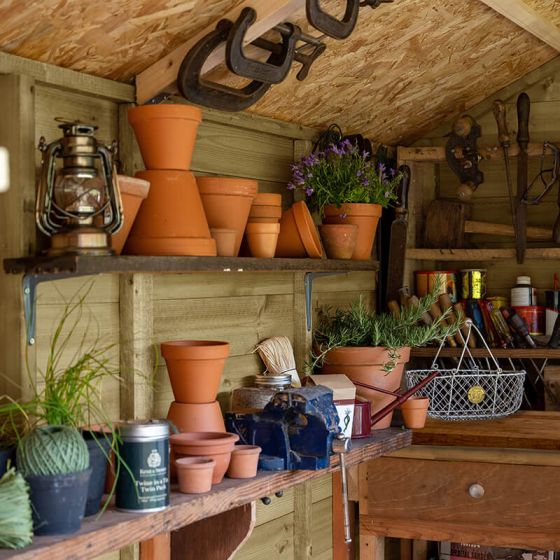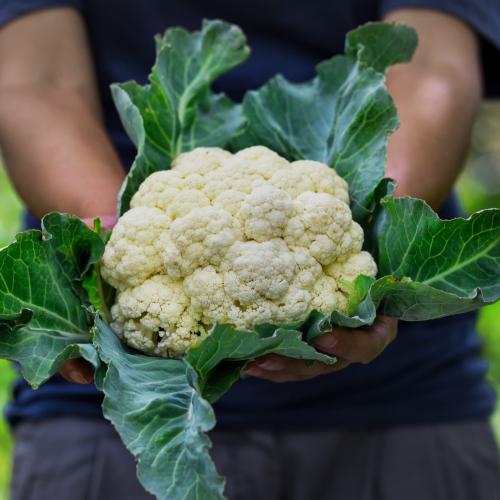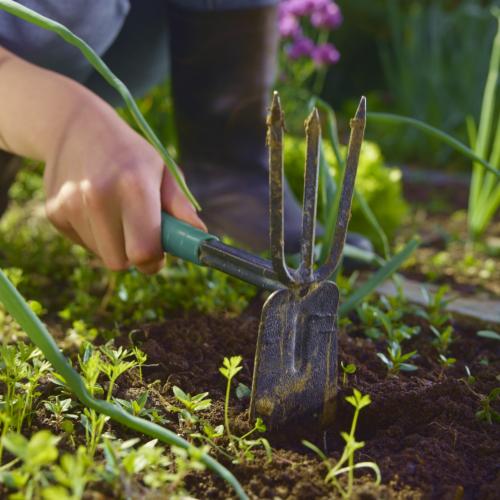March Hints & Tips
In March, the days are noticeably longer, and it’s an opportunity to get out into the garden to enjoy some early spring sunshine. Frosts and sometimes windy weather mean that some tasks must wait, but there is optimism in the air with warmer weather and longer days ahead.
As the weather gets warmer and plants start to wake up, so do pests and diseases, so it’s useful to make some early checks on the health of your garden.
Spring is here, and it’s time to get busy in the garden again...
Discover our gardening hints and tips for this March:
Continue scrolling to read our monthly newsletter...
From the potting shed...

Blue Diamond's monthly gardening newsletter, written by our Great Amwell plant department colleague, Chris Milborne.
March 2025
March is when gardening starts to get into top gear.
You will notice wild primrose flowers growing at the base of hedgerows and in woodlands, Hawthorn and early apple blossom beginning to open and the fresh green shoots of herbaceous perennials just starting to burst through the soil.
Wonderful HELLEBORES are just starting to come into full flower and as the Snowdrops fade, the early Daffodils and Crocus flower - just as you were beginning to forget where you had planted them last Autumn. There are two sides to March weather; on one hand the days are getting visibly longer, the soil is warming up and after a spell of warm Spring sunshine you will notice something new happening in your garden every day such as buds swelling, opening flowers, new growth and leaves. On the other hand, March can be extremely wet with chill winds and sharp frosts giving a wintry feel and delaying the onset of Spring.
Spring is the garden’s busiest time with all the planning, sowing, planting and propagation. Germinating seeds are ready to be pricked out and then potted on before planting out.
After this Winter’s mild, windy, wet weather it is now a good time for fencing and trellis repairs, checking plant supports and firming in any newly planted trees and shrubs that might have been loosened in the soil.
If your fencing has indeed been damaged, consider growing hedging plants as a boundary or in front of fencing if space allows. Hedging reduces wind speed and also reduces noise which is also a benefit. Mixed hedging such as BEECH, HORNBEAM HAWTHORN, climbing or rambling Rose, HONEYSUCKLE and CLEMATIS and include some evergreen plants producing a mixture of leaf shape and leaf colour. Some flower and some have scented flowers or produce berries and fruit which is great for providing a home to wildlife and improves air quality too.
Spring Clean
If the weather conditions aren’t too wet and the soil is not waterlogged, March is a good time and month for preparing seed beds, pruning roses, cutting back Winter flowering shrubs such as JASMINE NUDIFLORUM and pruning back the coloured stems of CORNUS (dogwoods) cutting back the oldest stems 15cm (6ins) from the ground. This stimulates new, brightly coloured young stems.
Prune BUDDLEIAS hard as this keeps the plants tidy and produces flowers at eye level. Also prune SAMBUCUS (ornamental Elders). The SAMBUCUS "BLACK LACE' produces wonderful dark leaves and stems and candy floss pink flowers. The only BUDDLEIAS not to prune would be ALTERNIFOLIA and BUDDLEIAS GLOBOSA as these flower on last year’s stems.
Prune LAVATERA as new green shoots appear cutting back the old wood and the new growth soon regrows for this year’s spectacular flowers in Summer. Coppice EUCALYPTUS to maintain a compact bushy growth. This produces attractive round juvenile foliage, good in floral arrangements rather than the lanced-shaped leaves of older, adult plants.
Start hoeing flower borders to keep annual weeds under control - although when I see weed seedlings germinating it is a sign that the soil conditions are warming up, enough to start the seed sowing process.
Tidy herbaceous borders - I do a Spring clean rather than an Autumn tidy, as I believe the old decaying leaves actually protect the dormant growth buds from cold weather. Then, when I see new growth appear I remove the old decaying foliage and leaf litter. I leave pruning of some of the more tender stemmed plants such as PENSTEMONS and SALVIAS until April or perhaps even early May until the risk of frost has passed.
Evergreen perennials like KNIPHOFIA and evergreen grasses are not cut back but just tided up. With PENSTEMON, cut back the old stems to a healthy bud, or with some varieties, like PENSTEMON ‘GARNET’ with its wine-red flowers, cut at the base as the new growth appears. This plant looks stunning when grown amongst ornamental grasses.
Having weeded the beds and borders, mulch over with a layer of organic compost, either garden compost or well-rotted manure, bagged soil improves or bark chips. This will help seal in the moisture, help to prevent weed seeds germinating and replace nutrients leached out by Winter rains. If plants are actively growing and the weather is mild, feed with a general fertilizer such as fish, blood and bone.
Add supports to herbaceous plants – there are many types available or you could use the pruning from coloured CORNUS stems to make natural, attractive support. By putting supports in early, plants grow naturally. Whereas if added later, this can result in branched or twisted stems that look less natural.
Divide herbaceous perennials as over time clumps spread out from the middle and become over grown and don't flower so well. It is best to dig them up and divide the root ball and discarding the old, central section. This really invigorates the plants, stimulating new growth and provides extra plants for free. There is a wide range of herbaceous perennials for all locations - sun and shade, dry and damp. There are so many available that have flowers either Spring or Summer to Autumn and it is a good idea to plant them amongst trees, shrubs, roses and grasses for a stunning mixed border.
Remove the dead flower heads of HYDRANGEAS, cutting back the stem to the first strong pair of healthy buds. As HYDRANGEAS flower on new growth, avoid cutting too low as this reduce flowering.
Lawns
Straighten and redefine lawn edges as this makes the garden look tidy.
If the weather is warm, re-seed any bare patches, rake and add some compost before sowing the seed thinly and firm in. However, if the soil conditions and temperature are not suitable, I tend to start working on the lawn in April.
Plant Highlights
FORSYTHIA (named after William Forsyth, a Scottish botanist) is a reliable and easy to grow shrub with masses of bright yellow flowers produced before the leaves appear and works well for the back of borders. FORSYTHIA is mostly native to Eastern Asia.
For year-round interest, plant with a mixture of later flowering shrubs or roses and offer perennials. Once the flowers are over, FORSYTHIA can look rather plain but it is a reliable plant nonetheless, especially in a mixed hedge for early season interest.
CAMELLIAS – There are some 220 species found in eastern and south East Asia and the leaves of CAMELLIA SINENSIS are used to produce Tea. Cultivated for Centuries in China before arriving in the UK in about 1740. This evergreen has shiny green leaves and single, semi double and double flowers in all shades of pink, red, white and cream. I find the white flowers and light cream are more affected by the weather conditions than the stronger pinks and reds.
CAMELLIAS enjoy being grown in a sheltered position in light shade and do best planted in well-drained, lime free soil with plenty of organic matter added. Avoid an East facing position for CAMELLIAS as morning frost can cause the flowers to turn paper brown. They make for a great plant in tubs and containers filled with ericaceous compost (i.e. lime free compost) or create a Japanese style garden with other RHODODENDRONS, AZALEAS, ACERS, ferns and grasses.
CHAENOMELES, the Japanese Flowering Quince, can be a slightly messy plant left to its own devices but is easy to train against a wall or fence to keep it tidy. There are many different varieties with large colourful apple blossom-like flowers in shades of pale red, peach and white followed by green spotted fruits that ripen to a golden yellow in October and November.
MAGNOLIAS appear in many forms from shrubs to trees. Shrubs like MAGNOLIA STELLATA, the star MAGNOLIA with white or pinkish white single flowers, compared to MAGNOLIA X SOULANGEANA with large waxy tulip-shaped flowers in light to dark pink colours. There is even an evergreen MAGNOLIA.
All Magnolias are stunning plants and they have been around for millions of years and pre-date the era of pollinating bees and butterflies as the flowers were originally pollinated by beetles. Magnolias make for a superb specimen plant with their beautiful and striking flowers often appearing on the bare stems before the foliage emerges. The early flowering varieties require a sheltered site from frosts, reasonable soil and positioned in sun or partial shade.
Other highlights include AMELANCHIER with its small, slightly pink blossom that smothers the base stems before the bronze-tinged, young foliage appears. Salix mount 'ASO' has fluffy pink catkins with a silvery sheen on bare stems.
SKIMMIAS, VIBURNUM TINUS, MAHONIAS, RIBES, VIBURNUM DAVIDII and CORYLUS AVELLANA "CONTORTA' all provide added interest plus the scented flowers of DAPHNE BHOLUA.
Springtime Classics
Classic Spring bedding includes Wallflowers that are highly scented and come in a huge range of colours and not forgetting the cheery colours of primroses and polyanthus plus violas and pansies. Daffodils and Crocus are now available in pots ready to add instant colour to containers, beds and borders. For colourful Spring containers plant up with Winter flowering heathers, rockery or alpine plants as well as early flowering perennials. Perhaps use a dwarf conifer for height and plant thyme or sedums to cascade over the edge.
Plant up year-round containers using topiary plants such as standard holly, yew, olives or compact evergreen shrubs such as RHODODENDRONS, HEBES, CAMELLIAS. Or how about a container for herbs including Bay, Lavender, Rosemary, Sage and Thyme.
Create a planting theme using rockery or alpine plants, dwarf bulbs, compact conifers and heather flowers - some with bright natural foliage. With this container add extra horticultural grit to the compost for better drainage, Top dress with horticultural grit, pebbles, stones and pieces of rock to create natural alpine look.
The perennial wallflower ERYSIMUM BOWLES MAUVE flowers for some 10 months of the year, the only downside is that the flowers aren’t scented.
Sow Hardy Annuals
Create a small wildflower area for attracting beneficial insects to the garden. Include Jacobs Ladder, Cowslip, Rad Campion, Ox Eye Daisy, Bird’s-foot trefoil, Teasles, Corn Poppy and Scabious.
Plan for Summer colour
March and April are the months to plant Summer flowering bulls such as Dahlia, Gladioli, lilies and Eucomis, together with herbaceous perennials (plants that die back and come back up each year). The Summer bulbs, depending on the varieties chosen, may produce flowers all Summer long and are great for creating colourful themes and displays in your garden and are a valuable source of cut flowers for the home.
Dahlias originate from Mexico, the tubers originally used by Aztecs as a food source and stems as water pipes. They produce diverse and colourful flowers in all shapes and sizes from July through to October and some provide striking two-tone flowers. The single types such as Bishop of Llandaff, Bishop of AUCKLAND and Dahlia Sunshine, with dark foliage are best for attracting bees and butterflies.
I start off Dahlia tubers off in pots in the greenhouse or a frost-free cold frame rather than plant directly outside where the cold, wet soil can rot the tubers. Growing on in pots produces larger plants when planted out in May, resulting in less damage from slugs and snails too.
If you need ideas and inspiration Blue Diamond Garden Centres have bulb collection packs available in a wide range of colour themes. For an exotic tropical look try CANNAS and EUCOMIS commonly known as the Pineapple lily and not forgetting Autumn flowering NERINES and AMARINES (a hybrid of an AMARYLLIS and NERINES).
Pot up the plug plants available in a bright, frost-free greenhouse, a cold frame or polytunnel and when grown they can be planted out in early May providing colourful flowering plants for hanging baskets, tubs and containers. With watering, feeding and regular deadheading you will have colour all Summer.
Start your Begonia tubers into growth by laying them concave side up on compost in a seed tray on a warm windowsill and once new buds are visible pot them up individually into 5inch pots approximately 1inch (2.5 cm) deep. Keep the top of tuber just above soil level and grow them on in a frost-free environment and plant out mid-May. Sow some sweet pea seeds for beautiful Summer colour and fragrance and make a couple of sowings for continuous flowers over a longer period.
Grow your own Fruit and Vegetables
Plant onions, shallots and Garlic cloves and if the soil is still cold or too wet start them off individually in modular trays to be planted out later when they are actively growing and soil conditions improve.
As a guide when cultivating the ground, if the soil sticks to your boots it is best to wait for another couple of weeks until conditions improve.
Hoe and rake where previously forked over to produce a nice fine tilth then sow lettuce, Rocket, Radishes, Spring Onions, Leeks, Parsnips and Spinach. I start Peas and Broad beans in modular trays. I prefer to start lettuce off in the greenhouse and plant out when nice strong, sturdy plants to avoid slug damage.
During the first week of March, I sow Tomatoes, Chillies, Sweet peppers and Aubergine in a heated propagator. When germinated and large enough to handle (when the first true leaves appear), I prick them out into 3inch pots and grow on in a warm greenhouse. When they are large enough, pot them up in to 5inch pots so they are not pot-bound producing better, stronger plants.
For delicious fruiting crops, plant Rhubarb and other pot-grown fruit such as Blackcurrants, Red and White Currants, Gooseberries, Blackberries, Raspberries and Strawberries. If the soil is not suitable, grow Blueberries in containers with ERICACEOUS compost. As well as a delicious fruit they are an attractive shrub to grow with interesting bark and good Autumn foliage colour.
Divide herbs like Mint and Chives by lifting the whole plat and then using a trowel or a spade to divide the root into sections. Mint can be invasive so plant in a container and this can be buried in the ground. For other herbs, replant the root sections into new soil.
When harvesting cabbage, kale and Brussel sprouts leave the stem in as they continue to grow new leaves which are useful for cooking and an added harvest before other vegetables are available.
At the end of March, plant out your 1st and 2nd early potatoes now 'chitting’. For main crop potatoes, plant out seed potatoes in April.
Have some horticultural fleece ready for any frosty nights to cover vulnerable plants.
Houseplants
Pot up any houseplants that are becoming pot bound and top dress larger containers with fresh compost. Start giving houseplants a regular feed as this is often forgotten.
Finally, Mother’s Day - Sunday 30th March
There are so many interesting foliage and flowering houseplant arrangements to choose from at our centres, although for me nothing beats the beauty and long flowering period of the fascinating Orchid family. No need to worry about what to give as we have a wide range of both indoor and outdoor plats to choose from including our readymade, colourful outdoor planted containers for the garden.
March is a busy time in the garden and the improving, warming weather allows us to enjoy the new season. Visit gardens for ideas and inspiration and start planting trees, seasonal shrubs and roses.





